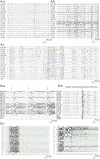PURA- Related Developmental and Epileptic Encephalopathy: Phenotypic and Genotypic Spectrum
- PMID: 34790866
- PMCID: PMC8592566
- DOI: 10.1212/NXG.0000000000000613
PURA- Related Developmental and Epileptic Encephalopathy: Phenotypic and Genotypic Spectrum
Abstract
Background and objectives: Purine-rich element-binding protein A (PURA) gene encodes Pur-α, a conserved protein essential for normal postnatal brain development. Recently, a PURA syndrome characterized by intellectual disability, hypotonia, epilepsy, and dysmorphic features was suggested. The aim of this study was to define and expand the phenotypic spectrum of PURA syndrome by collecting data, including EEG, from a large cohort of affected patients.
Methods: Data on unpublished and published cases were collected through the PURA Syndrome Foundation and the literature. Data on clinical, genetic, neuroimaging, and neurophysiologic features were obtained.
Results: A cohort of 142 patients was included. Characteristics of the PURA syndrome included neonatal hypotonia, feeding difficulties, and respiratory distress. Sixty percent of the patients developed epilepsy with myoclonic, generalized tonic-clonic, focal seizures, and/or epileptic spasms. EEG showed generalized, multifocal, or focal epileptic abnormalities. Lennox-Gastaut was the most common epilepsy syndrome. Drug refractoriness was common: 33.3% achieved seizure freedom. We found 97 pathogenic variants in PURA without any clear genotype-phenotype associations.
Discussion: The PURA syndrome presents with a developmental and epileptic encephalopathy with characteristics recognizable from neonatal age, which should prompt genetic screening. Sixty percent have drug-resistant epilepsy with focal or generalized seizures. We collected more than 90 pathogenic variants without observing overt genotype-phenotype associations.
Copyright © 2021 The Author(s). Published by Wolters Kluwer Health, Inc. on behalf of the American Academy of Neurology.
Figures



References
LinkOut - more resources
Full Text Sources
